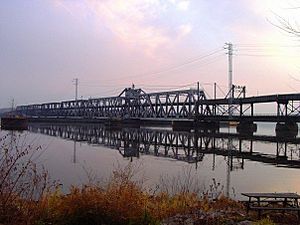Fort Madison Toll Bridge facts for kids
Quick facts for kids Fort Madison Toll Bridge |
|
|---|---|
 |
|
| Coordinates | 40°37′37″N 91°17′45″W / 40.62694°N 91.29583°W |
| Carries | 2 lanes of IA 2 and IL 9 and rail lines |
| Crosses | Mississippi River |
| Locale | Fort Madison, Iowa, and Niota, Illinois |
| Other name(s) | Santa Fe Swing Span Bridge |
| Maintained by | BNSF Railway |
| History | |
| Opened | July 26, 1927 |
| Statistics | |
| Toll | $2.00 (eastbound only (to IL)), per vehicle |
|
Fort Madison Bridge
|
|
| MPS | Highway Bridges of Iowa MPS |
| NRHP reference No. | 99001035 |
| Added to NRHP | August 27, 1999 |
The Fort Madison Toll Bridge is a special kind of bridge that crosses the Mississippi River. It connects Fort Madison, Iowa, and Niota, Illinois. This bridge is unique because it has two levels! The bottom level is for trains, and the top level is for cars. It's also known as the Santa Fe Swing Span Bridge. When it was built in 1927, it was the longest and biggest double-deck swing bridge in the world.
Contents
About the Fort Madison Bridge
The Fort Madison Toll Bridge is a very important bridge. It helps people and trains cross the mighty Mississippi River. This bridge is a "swing bridge," which means a part of it can swing open. This allows big boats and barges to pass through easily. It's also a "truss bridge," which means it's built with strong triangle shapes to make it very sturdy.
The bridge is about one mile long. A large section in the middle, called the swing span, is about 525 feet (160 meters) long. This part is what opens up for river traffic. The bridge was built to replace an older, smaller bridge from 1887.
How the Bridge Works
Imagine a giant door that opens in the middle of a bridge! That's how the Fort Madison Bridge works. When a boat or barge needs to pass, the middle section of the bridge swings open. This creates a clear path for the river traffic.
River traffic gets to go first. This means boats and barges have the right-of-way over trains and cars. The time it takes for the bridge to open and close can change. It depends on the weather, how fast the river is flowing, and how many boats are waiting. A typical opening for a large group of barges might take 15 to 20 minutes. The bridge opens more than 2,000 times each year! That's more than five times every day.
What the Bridge Carries
The Fort Madison Toll Bridge is a "double-decker" bridge. This means it has two levels for different types of traffic.
- Lower Deck: This level is for trains. It's a very busy railway line for the BNSF Railway. About 100 trains cross the bridge every day! This includes Amtrak's Southwest Chief passenger train.
- Upper Deck: This level is for cars. It carries two important roads: Iowa Highway 2 and Illinois Route 9. Iowa 2 starts here and goes west into Iowa. Illinois 9 starts here and goes east into Illinois.
The bridge opened for traffic on July 26, 1927. The very first time it opened for a boat was at 11:58 a.m. on that day.
Rules for Cars
As of 2018, the top part of the Fort Madison Toll Bridge is open for cars. However, there are some important rules to follow:
- It is not open for large semi-trailer trucks.
- The maximum weight for vehicles is 16,000 pounds (or 8 tons).
- Vehicles can be no wider than 8 feet.
- The height limit is 14 feet, 4 inches.
- The length limit for vehicles is 60 feet.
There is a small fee, or "toll," to cross the bridge if you are driving east into Illinois.
A Historic Landmark
The Fort Madison Bridge is more than just a way to cross the river. It's also a historic landmark! In 1999, it was added to the National Register of Historic Places. This means it's recognized as an important part of history. It's a great example of engineering from the early 20th century.

